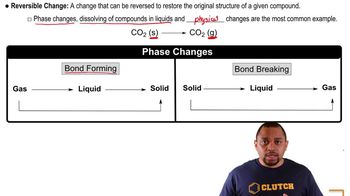Consider the following equilibrium: 2 H2(g) + S2(g) ⇌ 2 H2S(g) Kc = 1.08 × 107 at 700°C (c) Calculate the value of 𝐾𝑐 if you rewrote the equation H2(g) + 1/2 S2(g) ⇌ H2S(g)
Ch.15 - Chemical Equilibrium
Chapter 15, Problem 26a
Consider the following equilibrium, for which at 𝐾𝑝 = 0.0752 at 480°C: 2 Cl2(𝑔) + 2 H2O(𝑔) ⇌ 4 HCl(𝑔) + O2(𝑔) (a) What is the value of 𝐾𝑝 for the reaction 4 HCl(𝑔) + O2(𝑔) ⇌ 2 Cl2(𝑔) + 2 H2O(𝑔)?
 Verified step by step guidance
Verified step by step guidance1

Verified video answer for a similar problem:
This video solution was recommended by our tutors as helpful for the problem above.
Video duration:
1mWas this helpful?
Key Concepts
Here are the essential concepts you must grasp in order to answer the question correctly.
Equilibrium Constant (Kp)
The equilibrium constant, Kp, is a numerical value that expresses the ratio of the concentrations of products to reactants at equilibrium for a given reaction at a specific temperature. It is calculated using the partial pressures of gases involved in the reaction. A Kp value less than 1 indicates that at equilibrium, reactants are favored, while a value greater than 1 indicates that products are favored.
Recommended video:
Guided course

Equilibrium Constant Expressions
Reversibility of Reactions
Chemical reactions can proceed in both forward and reverse directions, and the equilibrium constant for the reverse reaction is the reciprocal of the forward reaction's equilibrium constant. This means that if you know Kp for a reaction, you can easily find Kp for the reverse reaction by taking the inverse of that value. This principle is crucial for solving equilibrium problems.
Recommended video:
Guided course

Reversible Changes in Matter
Stoichiometry in Equilibrium
Stoichiometry refers to the quantitative relationship between reactants and products in a chemical reaction, as represented by the balanced equation. In equilibrium expressions, the coefficients of the balanced equation become the exponents in the Kp expression. Understanding stoichiometry is essential for accurately calculating equilibrium constants and predicting the direction of the reaction.
Recommended video:
Guided course

Stoichiometry Concept
Related Practice
Textbook Question
Textbook Question
At 1000 K, 𝐾𝑝 = 1.85 for the reaction SO2(𝑔) + 12 O2(𝑔) ⇌ SO3(𝑔) (c) What is the value of 𝐾𝑐 for the reaction in part (b)?
Textbook Question
The following equilibria were attained at 823 K:
CoO(s) + H2(g) → Co(s) + H2O(g) Kc = 67
CoO(s) + CO(g) → Co(s) + CO2(g) Kc = 490
Based on these equilibria, calculate the value of 𝐾𝑐 for H2(𝑔)+ CO2(𝑔) ⇌ CO(𝑔) + H2O(𝑔) at 823 K.
Textbook Question
Consider the equilibrium N2(𝑔) + O2(𝑔) + Br2(𝑔) ⇌ 2 NOBr(𝑔) Calculate the equilibrium constant 𝐾𝑝 for this reaction, given the following information at 298 K:
2 NO(𝑔) + Br2(𝑔) ⇌ 2 NOBr(𝑔) 𝐾𝑐 = 2.02
NO(𝑔) ⇌ N2(𝑔) + O2(𝑔) 𝐾𝑐 = 2.1×1030
